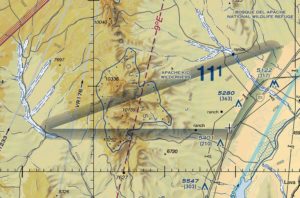My schedule has been affecting my posts but I’m going to attempt some short blogs about problems I see in Practical tests. This one is about airspace for the private airplane practical test (and commercial for that matter). Area of Operations 1, Task E requires the applicant to know the VFR weather minimums for “all classes of airspace”. This leads to item 2 of this task which requires knowledge of the rules for each class of airspace. One area that is a problem is where Class E starts and/or where Class G airspace ends as you climb or descend. Look at this sectional from my flying area. Note the point I’ve labeled “A”. A typical scenario question might
be “you’ve departed on your flight today and you are level at 1000′ AGL in this area. What are the visibility and cloud separation requirements?” This requires that you know this is Class G airspace up to 1,200′ AGL. The answer I get too often is that Class G in this area extends to 10,000′ MSL! I don’t understand the 10K because all airspace above 14,500 MSL is Class E but in this case it starts at 1,200′ AGL. I think the 10,000 MSL answer stems from the change is visibility above 10,000′ MSL (§91.155). Note the airspace below is Class G above 1,200′ AGL and
up to by not including 14,500′ MSL. There isn’t much of this Class G above 1,200′ AGL east of the Mississippi (not sure if there is ANY east of the Mississippi these days). Ok, back to the first photo – note area B. This is where Class E extends down to 700′ AGL or Class G extends up to 700′ AGL and is generally around an airport or areas with lots of traffic/airports. For some reason many seem to get this one right but don’t know where Class E starts outside the 700′ magenta shaded area. For your practical test you should know all the visibilities and cloud clearances in Class G and Class E. Don’t forget the other airspace either! More on that in another blog. In the meantime I found a good source online at the Bold Method web site.


